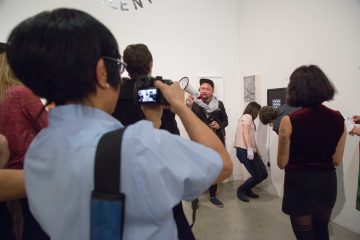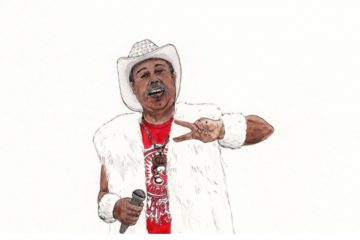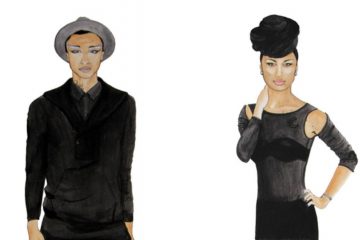DRAWN FROM THE CITY: Tahara
DRAWN FROM THE CITY: Illustrations and Interviews of SF’s Best, first appeared in The Bold Italic in 2015 and ran through 2016. We at broke-assstuart.com liked them so much we asked Crystal if we could put them out again as a time capsule of SF’s creative scene during the height of the most recent tech boom and demographic change.
All Illustrations & Interviews
By Crystal Vielula
@crystalvielula

Tahara, by Crystal Vielula
Where would you go if you get evicted?
That’s a good question I haven’t found an answer yet. Everything is so expensive now. Our place is relatively cheap we pay $1200 a month; someone said the new owners could easily get $6,000 for it now.
How were you able to fight the first round of buyouts?
Well the old landlord was old and had a heart attack. He wanted to sell because he didn’t want his wife to have to deal with it after he died. These speculators bought it called Urban Green and the tenant activists told us that they were the worst landlords. They were trying to evict a 98-year-old woman from another property they bought. While they were trying to get her out it hit national news and the media freaked out. She told them they were going to have to carry her out feet first, she could barley get up off the couch. Because they got such bad publicity, they decided not to evict her.
When they bought our building they immediately sent us a letter saying we want you out. They gave us thirty days to move. I knew it was a bluff because I worked for the Housing Rights Committee for 12 years. I knew all of the tenants’ laws. We had at least 15 lawyers involved. We had meetings with the Tenants’ Council and the Land Trust was even going to try and buy the building and turn it into a non-profit. It was an endless amount of changes all happening very fast. They threatened us with the Ellis Act, which would limit the buy out to $5,000 instead of the $40,000 they were offering each tenant. My neighbors got scared and all took the buyouts. But I thought I am just going to stay here as long as I can because I don’t have any money and didn’t want to be stuck once the money ran out paying higher rent somewhere else with no income.
Immediately after my neighbors moved the owners sent in crews of construction workers. For 11 moths they were hammering and sawing from as early as 6:30 in the morning to as late at 8:00 at night, sometimes 6 days of week. We used to have the most beautiful garden here, they took out my peach tree and my Santa Rosa Plum that gave us so much delicious fruit and flowers and bees. I came outside one day and one of the gardeners was just hacking the trees up.
Now the building is for sale again and we have had all of these rich people with fancy cars from all over the world come to see it. It’s being sold for 3 million dollars; it’s amazing the original landlord bought it for 80,000. The current owners are going to make a million dollars in one year.
How was it working for Housing Rights?
I liked working at housing rights it was all legal work. People would come in with housing issues and you are supposed to know the laws and advise them. I enjoyed that very much and was there for 12 years. But when my building was bought I stopped doing it because I had to concentrate on the house and get rid of huge amounts of stuff. If I have to leave I can’t store all of that stuff.
Are you doing this alone?
I have a partner, a black man named Arnold Rice; we’ve been together for 10 years I dearly love him. He has his own place over by Duboce Park. We spend a lot of time together. We met at the 60th birthday party of one of the Cockettes. At that time I was working on this thing called the Neighborhood Fix It Chart. In those days there was nothing but gangs, thugs and drug dealers in this neighborhood (the Mission) and they were all shooting each other. All of the gay guys on the street and I got the shit beaten out of us. When you called the police they would give you different numbers to call and it took forever to get anything done. So finally I decided to write down the solutions, the different numbers to call for specific issues. I started publishing a booklet with all the information called the Neighborhood Fix It Chart, which I did for fifteen years. It was free and it told you what number to call for any problem you were having in your neighborhood. I updated the numbers every 6 months. I used to go to all of the neighborhood meetings and give them out. The board of supervisors saw it and they liked it so much that they created 311 based on it.
When did you move to the Bay Area?
I came here in 1969 when the hippies were happening. I lived in Dallas Texas at the time with my family and Texas was not happening for me. It was very uptight, redneck, and hateful. So I ran away from home when I was 18. I told my parents I would be back in a week, but I didn’t go back for 33 years and when I went back I didn’t recognize them.
Then the hippie movement kind of died and the gay thing started happening where people started coming out and expressing pride. There was a lot happening out here that’s why I liked it. I’ve been here ever since but now it looks like I may have to leave finally if they want us out of here. so I’ll jus start over somewhere else.
What was San Francisco like when you moved here?
When I moved here I wanted to be a free person. The city itself was much more liberal than Texas. Also there were a lot of gay people here and they weren’t oppressed. By the time I was in the Cockettes no one bothered us in the theatre world but on the street you could still get beat up. It was cheap to live here; the city was in decay because a lot of people at that time were moving to suburbia. These old houses were run down, they had iron pipes for plumbing and when you turned the water on it came out brown. The whole spirit of a revolution was occurring in the city. There were all these things happening at the same time like Women’s Lib, anti Vietnam War protests, Gay Liberation, Black Liberation, Black Panthers. I was being young trying new things that my parents would have never done. It was fun.
When I first moved to the city I had a friend who was a drag queen who lived as a women, named Ebony and he lived in a hotel with other drag queen prostitutes in Hayes Valley (which used to be an all black neighborhood before it got yuppified). So I lived there with her for about a month. Next door lived one of the guys who had been in the famous 60’s rock group The Platters. He was completely crazy and he used scream and throw knives at the wall in the middle of the night. Then the Cockettes had a room open up in their basement so we moved in there for about a month. One night we were doing a show, in those days we had a 40s ambulance that we used to ride around in that could fit twelve Cockettes in makeup in the back of it, Scrumbly would drive he was the only one that had a license. When we came home and there were fire trucks in front of the house and the top floor had burned down. Someone had forgot and left a candle burning. A week later we had friends, Patty Cakes and Charles, who we always called Chaz Darling, who were moving to the country so their flat was for rent. We moved in there, my share was $32 a month. It was cheap but we had no food, we ate brown rice flavored with soy sauce and oregano everyday. We would go out and pan handle to get something extra money.
How did you get involved with the Cockettes?
What a story. Well I was a hippie and I was coming out of the closet in 1969 and I was living in Berkeley in a crash pad with a bunch of hippies from Texas that my father and mother hated. I had to sneak around to visit with them. It was very dangerous in Texas to be a hippie, my god. They would arrest you just for having long hair. Quite often they would plant marijuana on you so they could send you to prison. That’s why we decided to come out here, some cops stopped us and told us if they saw us again they would plant pot on us so we better get out of town. My father would have lost it if I’d got caught with pot he would have put me in a mental institution.
Anyways, I used to see a man occasionally in the street all dressed in robes and feathers sticking out of his head with a big crown of flowers, just beautiful. He used to dance in the street and I wondered who he was. One night I was at Altamont and that man was there all dressed up in his elaborate robes with his long blond hair and his long blond beard and moustache. He was very pretty so I decided to go up and meet him. At this point he had inspired me so I started making costumes and wearing them in public also. His name was Hibiscus and he told me he was starting a theatre group in San Francisco and he wanted me to be in it. He gave me an address on a piece of paper and he told me the name of the group was the Cockettes. We were going to perform at the Palace Theatre, which was huge Art Deco theatre that held 2,000 people. We didn’t have to pay for it because everything was converting to T.V. so all of these theatres were empty. They were glad to have something happen. There was also an underground film night that happened on Saturdays and you’d see stuff like thirties movies, Busby Berkeley, John Waters, cult, anything bizarre. It was owned by two Chinese men who didn’t care if you took drugs or drank as long as the police didn’t come. This had been going on for a year and Hibiscus asked to do a theatre show between the break during the film night. So we did a number on stage, we just danced to a rolling stones song in drag. They loved it and asked us to do more. Then we started putting together music and a stage show. I was only with them for a year though. In that year they became very famous and of course we had no managers, no money, nothing. We were just poor gay hippies and it became very crazy and difficult to deal with, I was only nineteen. Someone suggested starting a free theatre group so I decided to do that and dropped out of the Cockettes. I got Hibiscus and Ebony and Harlow to join the free theatre project with me. Hibiscus, he was a real drama queen. After leaving the Cockettes and missing out on going to New York with them he was really upset. He felt he needed to be crucified to release all of his past temptations towards fame and then he would comeback from the dead as an Angel of Light with a whole new attitude. It lasted about a year.
How was it being a part of the Cockettes?
Most people don’t talk about it but it was very competitive. One year there was a scene in a Halloween show where three different guys in the cast wanted to be the Bride of Frankenstein and they were all fighting over it. Finally two of them united and decided that they could both play the Bride of Frankenstein if they were lesbian Siamese twins. But they didn’t want the other one playing it and when she showed up the night of the show dressed as the Bride of Frankenstein the other two locked her in the closet. Nobody knew she was in there and she had a LSD freak-out in the closet. They had to call an ambulance and in the middle of the Halloween show the EMTs came down the aisle with a gurney and got her off of the back wing of the stage and wheeled her out through the audience. Everybody thought it was part of the show.
What was the Angles of Light Theatre like?
I was in it for 7 years and directed the productions after Hibiscus left. By the time I dropped out of that there were 60 people in it. It was called the Angels of Light and they did shows for 15 years. The Angels of Light was a commune; there were 18 of us living in that 3 story Victorian with high ceilings over on Haight and Divisadero. We only had 4 women and one straight man in the Angels of Light the rest were gay men. We were there for 3 years and did a lot of shows around town. We had a communal treasury and we pooled all of our money. We made everything we could make, costumes, sets, lighting, we wrote the scripts. We had big meetings and would write the script together. We were very idealistic. We all had an open marriage, everyone in the commune was married to each other and we could sleep with anyone in the house. Except we had this one hetero couple and his wife didn’t want him sleeping with anybody but he did anyway. We had those kinds of problems, jealousy and people feeling left out. It was a difficult house to live in with people trying to get rid of egos.
The troupe became very famous in San Francisco, 2,000 to 3,000 people at a show. We did a show about Greek myths, a show called “Watusi in San Francisco” which was about Africa, one about the French Revolution called “Paris Sights under the Bourgeoisea”. The worst show we ever did was a hospital show about removing an 18-foot tapeworm from this man. We played doctors and nurses and everybody in the cast was drunk except for one respectable lady. It was wild times. Allen Ginsburg was in some shows he and Hibiscus were lovers.
People got into learning dances and disciplines and the funny problem that happened was that people would get into some type of theatre art like tap dancing or Flamenco and we would have to write shows that would start off in Spain so that person could do Flamenco dance and then they got on a boat and went to China so that this person could do Chinese Opera it just broke apart in that way.
After I dropped out of the Angels of Light; I dropped out because I felt the group was going in a direction in which I was not interested. I was a theatre person and there was no interesting theatre happening in the city s and felt like there was nothing here for me. After the Angels of Light I lived alone for several years. Then tiring of living and being alone, and by then a severe alcoholic I traveled allover the world for 7 years. I went to Egypt, Greece, Hong Kong, Malaysia, Sri Lanka and Bali. Then when I came back to my native land volunteerism had begun so I started interning; I volunteered for many years at the Haight Ashbury Food Program, Housing Rights Committee, and the Marine Mammal Center and others.
When did you start performing?
My father had been a rodeo clown in Texas so I had grown up in the rodeo world as a clown. My father played mainly small towns. He had a partner named Stringbean, who was very tall and would wear very long shirts and his pants up around his knees. My father had a trained mule that could do 17 different tricks. In ‘57 he decided that he wanted me in the act and I was going to play his wife, I was a tiny 7-year-old drag queen with wig made out of yarn. That’s where I got my theatre beginnings. I did rodeo shows until I was about 15. After that I worked a Wild West show over at Six Flags. I played a Confederate soldier and I had to save the stagecoach from the Indian attack that was fun.
How long does it take to make a costume?
Six months for a really elaborate costume or one day if it’s pretty simple. I like to make costumes. I made the costumes for the Thrillpeddler’s revival of the Cockettes show Pearls Over Shanghai.
I had a costume that I made for an Angels of Light show back in ‘75 out of my great grandfather’s ties from the 30s and 40s. I made them into a dress and I wore them on stage as a Spanish film star called Lyla Cortez. The Fashion Institute of New York has a museum, and they were doing an exhibit on gay designers. They were interested in the Cockettes and the Angels and they wanted a costume to put in their exhibit. So I sent them that dress and it was displayed in between Alexander McQueen and Balenciaga. I even got write up in Vogue, it’s not very big but it said my costume showed exuberance and excitement. I was pretty delighted.
How did you learn to sew?
My mother loved to sew and she used to make all of our clothes when we were young. My sister had these cute little dolls when I was little and I had a little doll too that I didn’t tell anyone about. I wanted my mom to make a dress for it so she started making it but she said if your father knew you had a doll and I was making a dress for it he would have a shit fit.
What was it like here during gay liberation?
The gay thing happened in the late 70’s. At one point in 76 or 77 there were 50,000 gay men in San Francisco. Whole streets were gay with bars dance clubs and sex clubs. It was sex sex sex sex sex sex; there was so much sex. Everywhere you went there was an orgy in the corner of the room. Every party had a back room where people were having sex. That was gay men; I don’t know about lesbians, they wouldn’t let men, gay or straight into their bars. They were very separatist because they didn’t want to be harassed. The Castro was raging; I went out dancing every single night. Of course I wound up with an alcohol problem, I was an alcoholic for 7 or 8 years.
My parents didn’t like gay people so we never had a relationship. My father could be a terrible bitch. He became an evangelical Christian when I was 14 and we had to go to church and pray all the time. I hated church.
Tell me about your art.
I’ve been doing photograph paintings for about two and a half years now. Before that I had always done theatre stuff. I was never interested in photography because it didn’t mean anything. Then I had this vision and ever since then I got interested in photography and photograph paintings. I feel like I have discovered 21st century art. You may ask what is 21st century art, well it has to do with what is being seen is not being seen. I wasn’t always a genius but I think I am now. You have to do a lot of nothing to be a genius.
Wow you have a lot of books!
They are all arranged according to the library of congress, which is all online. I put little catalog numbers on all of the books, I have Hollywood, gardening, cultures of the world, spirituality, art, applied sciences, science, sociology, geography. I find them at garage sales and whatnot. I have about five thousand.
(Picking up a book) This book came out not too long ago and is a compilation of all of the articles from the 60’s/70’s Kaliflower Commune newsletters. It includes articles about how to wash your ass with water instead of toilet paper to cut down on deforestation, how to eat vegetarian so you don’t kill animals all kinds of stuff. I think they made 1200 copies of the book. They distributed them free to people that had been involved or were interested in communal living. In those days the Kaliflower Commune’s contribution to the commune system was their free print shop. There was a different commune that did all the food, they went to the farmers market and bought all the food for all of the communes within the system with pooled food stamps and distributed it to everybody. With so many people involved in the communes there was a lot of energy. The communes didn’t really last because people got older and wanted different things. Our commune system, which included not only the Angels of Light and Kaliflower communes but other communes such as the food commune, had been all about doing things for free, selfless service it was called, money and private ownership within and outside the communes was frowned upon. According to the communal philosophy, personal money and property were to be given to the commune for the use of all. One thing I learned from my days of living in communes, follow the money, communes do eventually become businesses.




